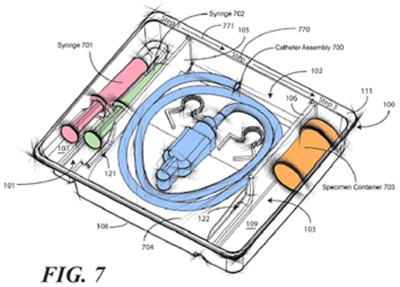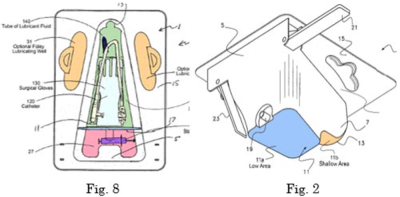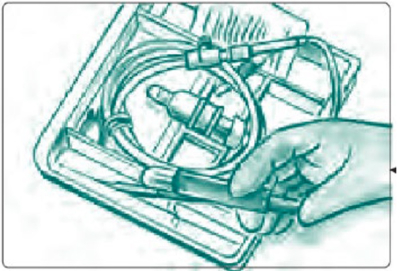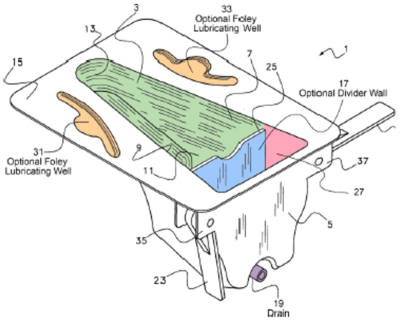In a nonprecedential decision, the Federal Circuit gave a mixture of success and failure to the parties in four separate inter partes review decisions by the Patent Trial and Appeal Board, in C.R. Bard, Inc. v. Medline Industries, Inc.
The case arose in IPRs instituted in response to a challenge by Bard involving three Medline Patents: U.S. Patent No. 9,745,088 (wherein claims 1, 2, 6–10, 16–19, 25–58, 60–74, 76–90, and 92 were challenged); U.S. Patent No. 9,808,596 (claims 7–16 and 21–22 challenged); and U.S. Patent No. 9,795,761 (claims 1–19 and 22–25 challenged). The claims are directed to trays designed to store urinary catheterization tools, which include a lubricant syringe, an inflation syringe, and a fluid receptable. They are useful in avoiding catheter-Associated Urinary Tract Infections (CAUTI), inter alia, by providing an organized, sterilized surface for the components used in catheterization according to a standardized protocol; a tray according to the invention is illustrated as Figure 7 of the '088 patent:

The opinion sets forth the aspects of the invention claimed in the patents challenged in each IPR:
• claims 1, 25, and 45 are representative of the '088 patent. Claims 1 and 25 are generally directed to a tray with two syringes positioned at different heights. Claim 45 is directed to a tray with two syringes in one compartment;
• claims 7 and 9 are representative of the '596 patent. Claim 7 is directed to a tray with a fluid receptacle positioned between the base and the catheter. Claim 9 is directed to a tray with a compartment configured to receive lubricant; [and]
• claim 10 is representative of the '761 patent and is directed to a tray with a lubricating jelly application chamber.
Bard challenged the claims of these patents for being obvious over four prior art references, each of which were (not surprisingly) directed to medical kits or trays:
• U.S. Patent No. 7,278,987 (Solazzo) disclosed a tray as set forth in Figures 2 and 8 below;
The relevant features are the two compartments in Figure 8 holding respectively an inflation syringe and a Foley catheter and tube of lubricant, the compartments separated by a divider that can be removed. Also, as illustrated in Figure 2, the bottom of the container has "deep" and "shallow" sections.

• U.S. Patent No. 3,329,261 (issued July 4, 1967 to Serany) disclosed a catheterization package containing components stored in their "proper order of use" to "assure that a sterile field may be maintained as the components are removed."
• U.S. Patent No. 3,166,189 (issued January 19, 1965 to Disston) disclosed a catheterization tray which, like Serany, has the components "arranged in such order and position as to be most conveniently available when the container is opened."
• Japanese Patent No. 2007-229520 to Imai disclosed an epidural anesthesia tray containing three syringes in a single compartment.
The Board's decisions, that the cited art did not establish by a preponderance of the evidence that the challenged claims were obvious, is synopsized in a table in the opinion:

None of the PTAB's opinion discussed either party's arguments regarding secondary considerations (or objective indicia) of non-obviousness and the opinions addressed similar arguments that the Court considered in this single appeal.
The Federal Circuit affirmed-in-part, vacated-in-part and remanded, in an opinion by Judge Lourie, joined by Judges Bryson and Chen. Bard argued that the Board erred and urged the Court to reverse the decisions without remand and without consideration of secondary considerations, while Medline argued that the decision should be affirmed on the grounds that the references were incompatible with one another (grounds the Board did not consider in any of the IPR proceedings, and regarding which Medline conceded at oral argument they were collaterally estopped from advocating on appeal).
The opinion took the Board decision on each patent in turn. Regarding the '088 patent, Claim 45 was representative:
A medical procedure kit, comprising:
a single layer tray having a first compartment for receiving syringes and a second compartment for receiving a medical assembly;
a first syringe and a second syringe disposed within the first compartment;
the medical assembly disposed in the second compartment, wherein the medical assembly comprises a coiled tubing coupled between a fluid drain bag and a Foley catheter;
at least one layer of wrap material enclosing the single layer tray within one or more folds of the at least one layer of wrap material; and
an outer packaging disposed about both the single layer tray and the at least one layer of wrap material.
(wherein the italicized limitations were relevant to the appeal). The basis for the Board's non-obviousness determination was that it was not obvious to store two syringes in one compartment in view of the prior art. The rationale for Bard's argument was that the Solazzo reference disclosed two syringes but was silent as to the location of one of them, and that it would have been obvious to put both in one compartment consistent with the disclosure that the components in the prior art tray were arranged "in logical step-by-step order." This conclusion was also supported according to Bard by the disclosure in Disston that components should be arranged in an order that they are "most conveniently available" upon use.
The panel asserts that they agree with Bard on this issue, on the ground that there were only two alternatives (putting the two syringes together or separately) and the skilled artisan could have availed herself of the option of putting the syringes together. "When two equally viable options are available, as here, then, without more, either one would seem to have been obvious" according to the Court's opinion. The opinion criticizes the Board's application of the law as being "rigidly focused" on the disclosures of each prior art reference without taking into account the "creativity[] and common sense" of a person of ordinary skill in the art, citing KSR Int'l Co. v. Teleflex Inc., 550 U.S. 398, 415, 417 (2007), and Randall Mfg. v. Rea, 733 F.3d 1355, 1362 (Fed. Cir. 2013). On this basis, the Court vacated the Board's decision regarding claims 45–58, 60–74, 76–90, and 92 of the '088 patent and remanded for further considerations.
The opinion next considered the Board's obviousness determination regarding claims 1 and 25 of the '088 patent; claim 1 recites:
A medical procedure kit, comprising:
a tray having a compartment for receiving a medical assembly;
a first syringe and a second syringe disposed within the tray;
at least one layer of wrap material enclosing the tray within one or more folds of the at least one layer of wrap material; and
an outer packaging disposed about both the tray and the at least one layer of wrap material, wherein:
the first syringe and the second syringe are ordered within the tray in accordance with their use during a catheterization procedure; and
the tray comprises a surface defining at least two compartments, the at least two compartments comprising a first compartment to support the first syringe and the second syringe; and
the first compartment comprising a base member that defines a mnemonic device indicating which of the first syringe or the second syringe should be used first in the catheterization procedure.
(wherein the italicized limitations were relevant to the appeal). The mnemonic device, according to Medline, relates to arrangement of syringes at different heights in the claimed tray, on the basis that a practitioner would "intuitively" use the syringe closest to the top of the tray first. The Board rejected Bard's argument that Solazzo taught such an embodiment on the grounds that the Solazzo reference did not disclose a "contour and shape" associated with positioning the lubricating syringe at an elevated height. But the Court agreed with Bard on this issue, again finding an overly rigid analysis of obviousness by the Board. The opinion sets forth the disclosure in Solazzo consistent with the claimed positioning of the syringes (the first containing lubricant, the second mediating inflation of a balloon attached to the catheter to keep it in place). This disclosure was supported by the teachings in the Serany reference that components in the tray be arranged "in proper order of use," according to the opinion. In the Court's opinion, "a skilled artisan would have been motivated to design a compartment with a bottom portion that would elevate one syringe above another, without the aid of other items" in view of the cited prior art. Regarding claim 25, which did not disclose the mnemonic device, the Board erred for not properly considering the teachings of the Imai reference regarding arranging syringes at different heights. According to the panel, "[g]iven the prior art disclosures and the finite number of predictable options, a skilled artisan would have been motivated to stack the syringes by height according to their order of use." On these grounds, the Court vacated the Board's decision with regard to claims 1, 2, 6–10, 16–19, and 25–44 of the '088 patent.
The Court next considered the Board's decision of non-obviousness for challenged claims 7 and 9 of the '596 patent, wherein representative claim 7 recites:
A catheterization kit comprising: a single level container defining a first compartment bounded by a first compartment base member and at least a first portion of a perimeter wall, the single level container defining a second compartment bounded, at least in part, by a second compartment base member and at least a second portion of the perimeter wall; a first syringe disposed within the first compartment of the single level container, the first syringe containing an inflation fluid; a second syringe disposed within the first compartment of the single level container, the second syringe containing a lubricating jelly; and a coiled medical device disposed within the second compartment of the single level container, the coiled medical device including a Foley catheter, a fluid receptacle, and a tube coupling the Foley catheter to the fluid receptacle, the Foley catheter and the fluid receptacle positioned within the second compartment such that the fluid receptacle is between the second compartment base member and the Foley catheter.
(wherein the italicized limitation was relevant to the appeal). Once again the panel agreed with Bard that the Board erred in not concluding that the claims were obvious based on "(1) undisputed testimony that practitioners access the catheter before the fluid receptacle during a catheterization procedure, (2) Serany's disclosure that a fluid receptacle can be stored together with the catheter, and (3) Serany's disclosure that 'all the components [are] arranged in logical step-by-step order.'" The opinion characterizes the Board's decision as "impos[ing] anticipation-like requirements on the prior art in determining obviousness." Regarding claim 9, the relevant additional limitation is that the first compartment is "configured to receive the lubricating jelly from the second syringe to lubricate a tip of the Foley catheter when the tip is placed into the first compartment" as shown in use:

For a change, the panel agreed with Medline on this issue, agreeing that the Board had substantial evidence for concluding that this claim was non-obvious because the relevant compartment was "too deep to store lubricant and facilitate catheter lubrication." This evidence included "expert testimony that compartment 27's depth would render it unsuitable to store lubricant for the catheter" and "that, because a doctor needs to measure the urine, "[h]aving lubrication" in the urine compartment could "ruin[]" the measurement." Bard's arguments, that "any chamber [of the claimed tray] regardless of size and shape" is "configured for receiving lubricating jelly and facilitating the lubrication of the tip of a catheter" was inconsistent with the disclosures in the prior art and that the issue was not one of proper vel non claim construction. Accordingly, the Court vacated the portion of the Board's decision of non-obviousness regarding challenged claims 7, 8, and 11–13 of the '596 patent and affirmed that decision regarding challenged claims 9, 10, 14–16, 21, and 22.
The last Board decision review by the Court related to the challenged claims of the '761 patent, wherein the opinion recites claim 10 as representative:
A Foley catheter container, comprising: a single layer tray comprising a surface defining at least two compartments separated by a barrier, the at least two compartments comprising: a first compartment comprising a first compartment base member, the first compartment to accommodate a first syringe and a second syringe; a second compartment comprising a second compartment base member; the Foley catheter, situated in the second compartment; the barrier separating the first compartment from the second compartment; the first compartment base member situated at a different height within the tray than the second compartment base member; the first compartment defining a lubricating jelly application chamber to lubricate the Foley catheter when passed from the second compartment into the first compartment of the single layer tray; further comprising a patient aid comprising post-procedure information, disposed on a first portion of the patient aid, for caring for the Foley catheter applied to a patient.
(wherein the italicized limitation was relevant to the appeal). The Court's opinion was based on Bard's arguments with regard to the divider between compartments taught in the Solazzo reference and illustrate in the opinion by this Figure:

The opinion characterizes Bard's arguments as being similar to those the challenger asserted regarding claim 9 of the '596 patent, and similarly agreed with Medline that substantial evidence supported the Board's non-obviousness determination. On the other hand, the panel agreed with Bard that the Board erred with regard to the Board's conclusions regarding the presence of two syringes in one compartment positioned at different heights (for the same reasons set forth in the opinion for challenged claims in other patents at issue) but held that error to be harmless in view of "the deficiency of the prior art concerning the lubricating chamber limitation [being] supported by substantial evidence and hence sufficient to establish nonobviousness." The Court thus affirmed the Board's non-obviousness determination regarding challenged claims 1–19 and 22–25 of the '761 patent."
Finally, with regard to the secondary considerations issue, the Court remanded these arguments to the Board (subject to whether Medline should be collaterally estopped on remand from making "certain secondary considerations arguments").
C.R. Bard, Inc. v. Medline Industries, Inc. (Fed. Cir. 2021)
Nonprecedential disposition
Panel: Circuit Judges Lourie, Bryson, and Chen
Opinion By Circuit Judge Lourie